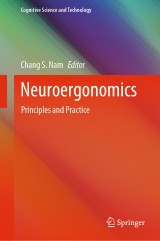Details

Neuroergonomics
Principles and PracticeCognitive Science and Technology
|
CHF 177.00 |
|
| Verlag: | Springer |
| Format: | |
| Veröffentl.: | 27.02.2020 |
| ISBN/EAN: | 9783030347840 |
| Sprache: | englisch |
Dieses eBook enthält ein Wasserzeichen.
Beschreibungen
<div>This book sums up key research findings, and theoretical and technological advances having a direct bearing on neuroergonomics. Neuroergonomics is an emerging area whose Neuroergonomics is an emerging area that is collectively defined as the study of human brain function and behaviour in relation to behavioural performance in natural environments and everyday settings. It helps readers to understand neural mechanisms of human cognition in the context of human interaction with complex systems, as well as understanding the change of perception, decision-making and training in humans. The authors give new insights into augmenting human performance, reflecting upon the opportunities provided through neuroergonomics research and development. </div><div><br></div>Computer systems acting on data from behavioural-output, physiological, and neurological sensing technologies are used to determine the user’s cognitive state and adapt the systems to change, support, and monitor human cognition. Various domains and case studies delve into the field of neuroergonomics in detail. These include, but are not limited to:<div><ul><li>an evaluation of technologies in health, workplace, and education settings, to show the different impacts of neuroergonomics in everyday lives;</li><li>assessment of real-time cognitive measures;</li><li>dynamic casual interactions between inhibition and updating functions, through analysis of behavioral, neurophysiological and effective connectivity metrics; and </li><li>applications in human performance modelling and assessment of mental workload, showing the reader how to train and improve working memory capacity.</li></ul><p></p><p><i>Neuroergonomics: Principles and Practice</i> provides academic practitioners and graduate students with a single go-to handbook that will be of significant assistance in research associated with human factors and ergonomics, human-computer interaction, human-systems engineering and cognitive neuroscience.<br></p></div>
<p>Brain Basics in Neuroergonomics.- The EEG Cookbook: A Practical Guide to Neuroergonomics Research.- Functional Near-infrared Spectroscopy (fNIRS) in Neuroergonomics.- Transcranial Direct Current Stimulation (tDCS): A Beginner's Guide for Neuroergonomists.- Adaptive Control of Thought-Rational (ACT-R): Applying a Cognitive Architecture to Neuroergonomics.- Deep Learning Techniques in Neuroergonomics.- Dynamic Causal Modeling Approach to Neuroergonomics.- Physical Activity and Sedentary Behavior Influence on Executive Function in Daily Living.- Neuroergonomics and Its Relation to Psychophysiology.- Hello Computer, How Am I Feeling?, Case Studies of Neural Technology to Measure Emotions.- The Neural Basis of Cognitive Efficiency in Motor Skill Performance Across Early Learning to Automatic Stages.- Approaches for Inserting Neurodynamics into the Training of Healthcare Teams.- The Neuroergonomics of Music Proficiency and Performance.- Hybrid EEG-fTCD Brain-Computer Interfaces.- The State-Of-The-Art Use of Brain-Computer Interfaces for Spinal Cord Injury Rehabilitation.- Brain-Computer Interface (BCI) Controlled Functional Electrical Stimulation (FES) for Hand Grasp Rehabilitation.- Neuroergonomics Behind the Wheel: Neural Correlates of Car Driving.- Fundamentals and Emerging Trends of Neuro-Ergonomics Application to Driving and Navigation.- Neuroergonomic Solutions in AR and VR Applications.- Neuroergonomic Applications in Information Visualization.- Neural Correlates and Mechanisms of Trust.</p>
Dr. Chang S. Nam is currently professor of Edward P. Fitts Department of Industrial and Systems Engineering at North Carolina State University, USA. He is also an associated professor of the UNC/NCSU Joint Department of Biomedical Engineering, Department of Psychology and Biomedical Research Imaging Center. He received a PhD from the Grado Department of Industrial and Systems Engineering at Virginia Tech in 2003. His research interests center around brain-computer interfaces, social cognitive and affective neuroscience, computational neuroscience, and trust in human-robot interaction. Dr. Nam has received the NSF CAREER Award (2010), Outstanding Researcher Award (2010-2011), and Best Teacher Award (2010-2011). He is the main editor of “Brain–Computer Interfaces Handbook: Technological and Theoretical Advances” (CRC Press). He is a recipient of the US Air Force Summer Faculty Fellowship Program Award in 2018. Currently, Nam serves as the Editor-in-Chief of the journal Brain-Computer Interfaces.
<p>This book sums up key research findings, and theoretical and technological advances having a direct bearing on neuroergonomics. Neuroergonomics is an emerging area whose Neuroergonomics is an emerging area that is collectively defined as the study of human brain function and behaviour in relation to behavioural performance in natural environments and everyday settings. It helps readers to understand neural mechanisms of human cognition in the context of human interaction with complex systems, as well as understanding the change of perception, decision-making and training in humans. The authors give new insights into augmenting human performance, reflecting upon the opportunities provided through neuroergonomics research and development. </p><p>Computer systems acting on data from behavioural-output, physiological, and neurological sensing technologies are used to determine the user’s cognitive state and adapt the systems to change, support, and monitor human cognition. Variousdomains and case studies delve into the field of neuroergonomics in detail. These include, but are not limited to:</p><div><ul><li>an evaluation of technologies in health, workplace, and education settings, to show the different impacts of neuroergonomics in everyday lives;</li><li>assessment of real-time cognitive measures;</li><li>dynamic casual interactions between inhibition and updating functions, through analysis of behavioral, neurophysiological and effective connectivity metrics; and </li><li>applications in human performance modelling and assessment of mental workload, showing the reader how to train and improve working memory capacity.</li></ul><p></p><p><i>Neuroergonomics: Principles and Practice</i> provides academic practitioners and graduate students with a single go-to handbook that will be of significant assistance in research associated with human factors and ergonomics, human-computer interaction, human-systems engineering and cognitive neuroscience.</p></div>
Helps readers gain an understanding of various of human cognition and behaviour through applications of brain-computer therapy and augmented-cognition technology Demonstrates in what ways human cognition can be augmented under various environments with theories, models and empirical findings Reviews the extensive research of augmented-cognition technology with a unique point of view Covers many of the open questions and challenges in augmented-cognition research today Contains ethical guidelines for augmented-cognition research

















